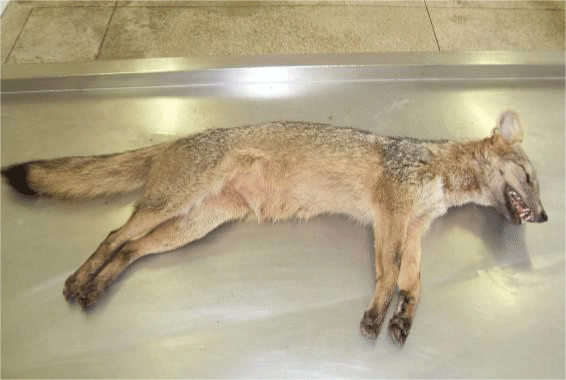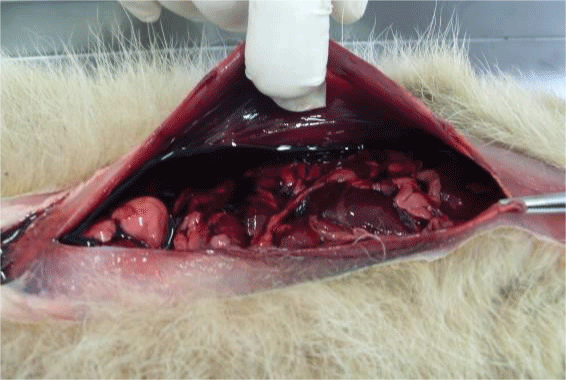
Figure 1: Carcass of C. thous running over victim with vehicle positioned in left lateral decubitus.


Lourdes Marina Bezerra Pessoa1* Paulo Roberto Bahiano Ferreira2 Carlos Humberto da Costa Vieira Filho3 Ianei de Oliveira Carneiro3 Gustavo Rodamilans de Macedo3 Rodrigo Arapiraca Pinto4 Paulo César Costa Maia3 Stella Maria Barrouin-Melo3 Eduardo Luiz Trindade Moreira3
1University of the state of Bahia, Bairro Flamengo, Barreiras, Bahia, Brazil*Corresponding author: Lourdes Marina Bezerra Pessoa, University of the state of Bahia, Bairro Flamengo, Barreiras, Bahia, Brazil, E-mail: lmarinabpessoa@gmail.com
Mortality due to road kills has a great impact on wildlife population. The Cerdocyon thous is a wild canid, presenting crepuscular and nocturnal behavior. This animal also inhabits metropolitan areas, due to the fragmentation of their habitat associated with intense imobiliary speculation. Hunting, infectious diseases and running over are the main threats to populations of wild canids in worldwide. Most of the reported cases of wildlife-vehicle collision occur on off-road and highways, with little information on the rate and the cause of mortality of wild canids in urban roads. The purpose of this report is to describe the gross necropsy lesions observed in a specimen of C. thous victims of running over on an avenue with heavy traffic within the urban area of the city of Salvador, Bahia, Brazil. The postmortem examination revealed pale mucous membranes, hemoperitoneum, hemothorax and numerous hemorrhages with the multifocal arrangement in the lungs. According to macroscopic findings of necropsy, we can conclude that the probable cause of mortality of the animal was hypovolemic shock resulting from multiple traumas. It is a necessary study on running over of wild animals in urban areas in Brazil be developed in search of knowledge on the subject to subsidize the urban planning measures with a conservationist approach and respect to the ecological elements of the country.
Running over; Necropsy; Fox; Trauma
The crab-eating fox, C. thous is a small canid with twilight and nocturnal habits, with extensive distribution in the savannas and forests of South America, from Uruguay and northern Argentina to northern of the South American continent [1].
The ability to adapt to different habitats contributes to survival in several types of vegetation, being able is found in fragments of forests close to urbanized areas [2]. The approximation of these animals to urban centers poses a risk to the survival of the species since the fragmentation of habitat generated by real estate speculation also exposes these animals to the risk of death by running over [3]. Wildlife-vehicle collision probabilities depend on animal movement patterns, landscape and features [4,5]. Animal movement patterns are the result of decision-making among behavioral trade-offs including an individual’s internal state, and its environment at different spatiotemporal scales [6]. When roads or railway lines intersect movement routes, these patterns can create zones of higher risk for wildlife conservation and human safety [4].
Several works have shown the impacts of roads more directly to wildlife [4-6]. In Brazil, there are scientific reports of some species of mammals as victims of running over, such as Didelphis sp., Tamandua tetradactyla, Chrysocyon brachyurus, Procyon cancrivorus and C. thous [3,7-9]. Such occurrences usually result in death without registration of veterinary care while the animal was alive [9,10], which may lead to underreporting of clinical cases of run-over in wild specimens.
Most of the reported cases of wildlife-vehicle collision occur on off-road and highways, with little information on the rate and the cause of mortality of wild canids in urban roads. Thus, the purpose of this case report is to describe the gross necropsy lesions observed in a specimen of C. thous victims of running over on an avenue with heavy traffic within the urban area of the city of Salvador, Bahia, Brazil.
A female specimen of crab-eating fox (C. thous) was rescued after being run over on Paralela Avenue, located in the Metropolitan Region of Salvador, Bahia. The animal was rescued with alive and it was sent to the Ambulatory of Wild and Exotic Animals (AASE) of the School of Veterinary Medicine and Animal Science (EMEVZ) of the Federal University of Bahia (UFBA). However, due to the severity of the injuries, the animal died on the way to AASE.
The necropsy of the animal was carried out in the Laboratory of Pathological Anatomy (LABAP) of the Hospital of Veterinary Medicine (HOSPMEV)-UFBA. The aesthetic technique was chosen in the accomplishment of the necropsy for later taxidermy.
In the post-mortem examination of the canid (Figure 1), pale mucosa (+), localized suffusion in the subcutaneous tissue and right abdominal oblique muscle accompanied by rupture of the muscle fascia, hemoperitoneum (100 milliliters) (Figure 2), hemothorax (50 milliliters), congestion, edema and hemorrhages were observed. It also detected splenic rupture at its caudal end with multifocal subcapsular hemorrhagic areas and numerous multifocal pulmonary hemorrhages. A complete fracture of the last lumbar vertebra with peripheral hematoma is also described.

Figure 1: Carcass of C. thous running over victim with vehicle positioned in left lateral decubitus.

Figure 2: Hemoperitoneum (100 mL) in carcass of C. thous running over victim with vehicle.
The post-mortem examination of C. thous showed that the animal presented a significant blood loss with intracavitary bleeding and ruptures of viscera, suggesting death due to hypovolemic shock as a result of polytraumatism.
Roads also act as barriers or filters, causing habitat fragmentation and the isolation of populations [11,12]. The animal this report was run over during the night while it moved to a patch of forest on the edge of the runway on an expressway. This avenue is an avenue of terrestrial communication for highspeed traffic that still divides fragments of the forest where several wild species inhabit. This interferes in the natural displacements of the specimens, increasing the risk of accidents and death by running over, especially of animals with nocturnal activity, as the case in question, due to the lack of light and the absence of signaling of the presence of wild animals on the highway [13]. All these impacts affect the immediate vicinity of the road and areas around the road system. Forman [14] showed that 22% of the contiguous USA is ecologically affected by roads.
The macroscopic findings of necropsy of C. thous suggesting death due to hypovolemic shock as a result of polytraumatism. Hypovolemic Shock is the clinical syndrome that results from inadequate tissue perfusion. This most common form of shock results either from the loss of red blood cell mass due to trauma, surgery, or internal hemorrhage and plasma from hemorrhage or from the loss of plasma volume alone due to extravascular fluid sequestration within the body or lost from the body or GI, urinary, and insensible losses. Severe pain may still be associated with trauma, may complicate the patient’s clinical condition during treatment because can of the development of neurogenic shock, resulting in death [15,16]. The accident by vehicles can lead to multiple trauma in the victim [17], such as fractures, dislocations, skin lacerations, ruptures of internal organs and hemorrhages, which can lead to clinical complications and death [18,19]. As we have seen in this case report.
Deployments of special signs, speed control, tunnel underpass crossing, hanging screens, removal of dead animals from the roadsides and the establishment of low speed in the area of transit of wild animals, are usually the actions that can be adopted by the competent bodies for the prevention of this type of accident [15,19], but should be used together for greater effectiveness due to the limitation of each method.
Wildlife-vehicle collision in metropolitan regions shows a need to verify the existence of a relationship between the increase of collisions and the state of health of the animals, once of poor health, for whatever reason, the animal may become a more fragile victim on the road. As in the case of an animal with rabies virus, which changes its mental state, soon the collision with vehicles becomes facilitated [20]. That shows the importance of epidemiological surveys of these animals.
The animal died due to hypovolemic shock, resulting from polytrauma caused by vehicle collisions within the urban area of a brazilian metropolis.
It is a necessary study on running over of wild animals in urban areas in brazil be developed in search of knowledge on the subject to subsidize the urban planning measures with a conservationist approach and respect to the ecological elements of the country.
At the Wildlife Screening Center (CETAS-IBAMA) and the Ambulatory of Wild and Exotic Animals (AASE/UFBA), Salvador, Bahia, Brazil.
The authors declare that they have no competing interests.
Download Provisional PDF Here
Article Type: CASE REPORT
Citation: Pessoa LMB, Ferreira PRB, Vieira Filho CHC, Carneiro IO, Pinto RA, et al. (2017) Necropsy Findings in Cerdocyon thous Victims of Running over: A Case Report. J Anim Sci Res 2(1): dx.doi.org/10.16966/2576-6457.109
Copyright: © 2017 Pessoa LMB, et al. This is an open-access article distributed under the terms of the Creative Commons Attribution License, which permits unrestricted use, distribution, and reproduction in any medium, provided the original author and source are credited.
Publication history:
All Sci Forschen Journals are Open Access